Illustrating a Devonian Predator
By Mary Alice Hartsock
July 16, 2018
A 10-foot-long, torpedo-shaped fish lurks through murky freshwater, its body casting a shadow on the creatures below. The opened mouth reveals dagger-like fangs, some two inches long, perfect for lacerating the flesh of fellow stream-dwellers.
Paleoillustrator Jason Poole dips the tip of his brush into a circle of white paint. Slowly and delicately, he dots the thickly painted canvas just beyond the predator’s gaze. From the shadowy background, particles emerge, gleaming as if reflecting the sun. Complete with vicious grin, his predator swims down for the kill.
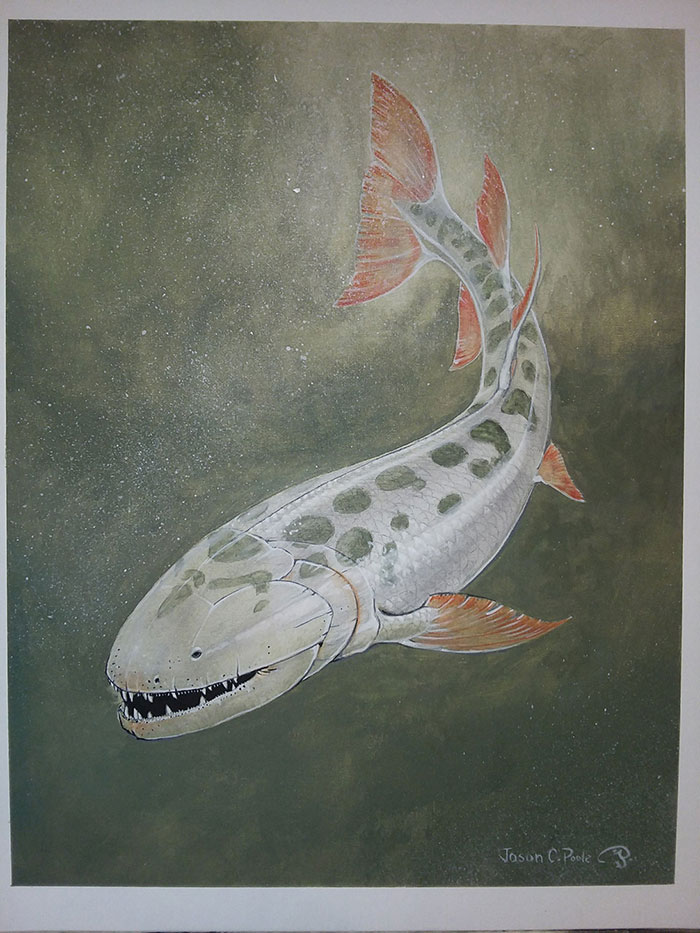
Poole was charged with depicting Hyneria lindae, the largest creature living in an ancient stream ecosystem in Devonian-age Pennsylvania, about 365 million years ago. This lobe-finned fish, belonging to a group of back-boned animals called sarcopterygians, was at least twice the size of the largest of the other animals with which it shared the waters.
When he received the Hyneria lindae assignment, Poole wasn’t concerned about the fish’s size. As manager of the Academy’s Fossil Prep Lab and Dinosaur Hall, he is used to depicting dinosaurs and other massive terrestrial animals. Tackling an aquatic monster—one without legs at that—was a challenge he eagerly accepted.
Rethinking a Prehistoric Fish
The request came from Academy Vertebrate Paleontologist and Drexel Professor Ted Daeschler and
Academy Research Associate Jason Downs, an assistant professor at Delaware Valley University. The scientists have been using fossils to trace the evolution of life in the Devonian Period for decades. One
of their most productive research sites is located just a three-and-a-half-hour drive northwest of Philadelphia, at a highway roadcut in Clinton County, Pennsylvania.
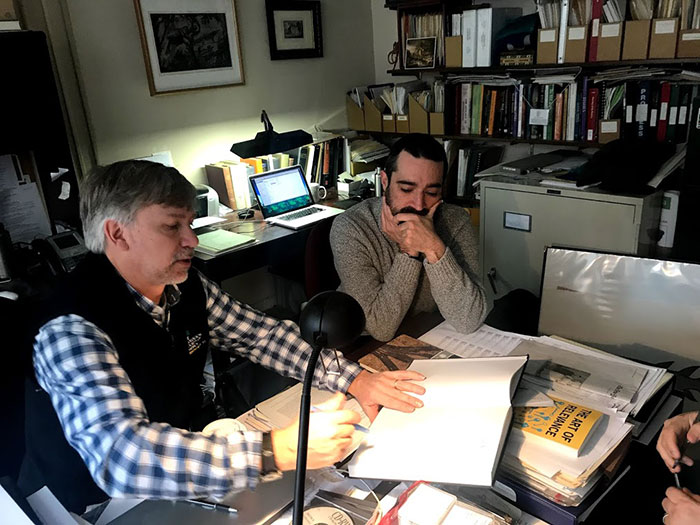
During the Devonian, subtropical streams flowed west through Pennsylvania toward a seaway in Ohio. These streams provided the ecological setting for plants, small invertebrates, armored fish, shark relatives and lobe-finned fish.
“The freshwater ecosystem in which Hyneria lindae lived was a hotbed of evolutionary change during the Late Devonian,” says Daeschler. “It was during this time frame that a closely-related branch of lobe-finned fish developed the earliest limb-like appendages.”
Eager to fit more pieces into the evolutionary puzzle, Daeschler and Downs studied fossils from the Academy’s collection that were brought here from the Clinton County site by Academy teams
during the past twenty-five years. They compared fossils of Hyneria lindae to closely related species to delineate the unique qualities of this predatory fish. They built upon the work of Keith S. Thompson,
PhD (Academy President 1987–1995), who described and named Hyneria lindae in 1968 based on limited fossil material collected at the same site in the 1950s.
Through the new fossils, scientists discovered that Hyneria lindae had a wider, more flattened head shape and a differently positioned and smaller eye than those of other similar creatures of its time. The group of bones that covers the gills and provides structure for the face was more narrow than previously thought.
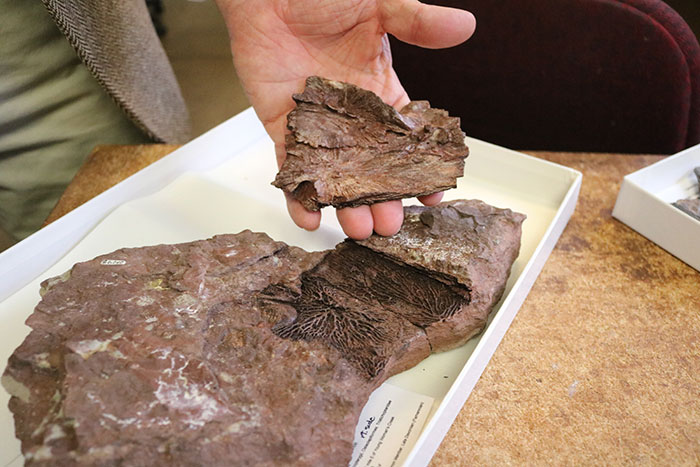
Daeschler and Downs also concluded that Hyneria lindae had an elaborate sensory canal system through its skull bones and scales, which enabled it to sense the movement of other organisms swimming nearby. This feature gave the fish a strong advantage for hunting and navigating deep channels within the sediment-laden streams.
Daeschler and Downs’ findings were published in the Journal of Vertebrate Paleontology in May. The scientists wanted an illustration of Hyneria lindae to help others visualize what the creature may have looked like in life. They didn’t have to look far to identify their artist.
Painting a Monster
An experienced paleoillustrator with a background in fossil excavation and preparation, Poole worked closely with Daeschler and Downs to depict this three-meters-long fish on an 11×14 canvas. He looked to fossils, modern-day fishes, previous illustrations of Hyneria lindae and his own imagination to bring life to the monster fish.
“This is a really beautifully ugly fish,” Poole says. “It looks like it wants to bite something.”

Poole’s initial sketches perfectly captured the undulating movement of the fish through the water, but the scientists tweaked the predator’s proportions. Hyneria lindae’s tail was too long, the fins needed to be moved and the curvature of its body was a bit off. Its skull was not shaped quite right, which threw off the placement of the eyes and nose.
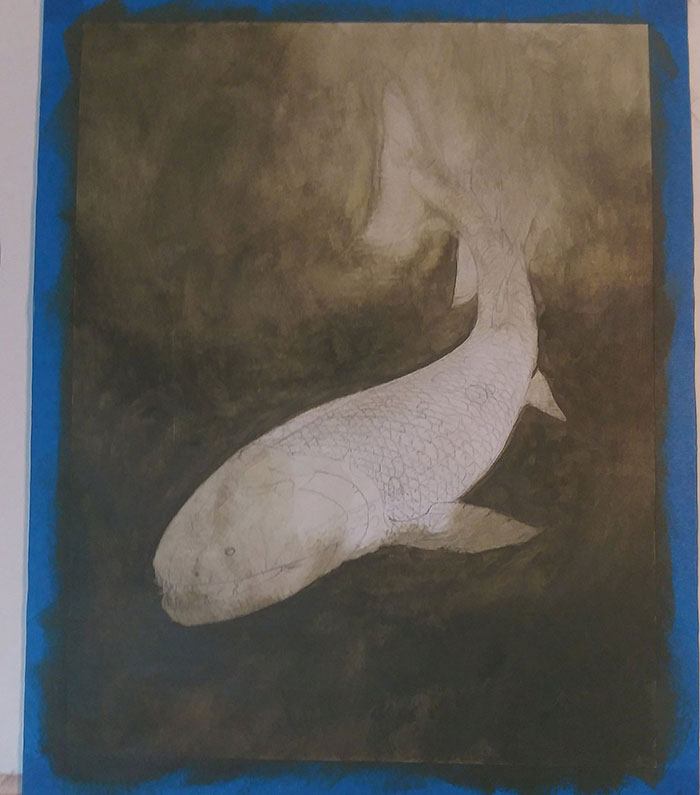
“Good paleo-art is art by committee,” Poole says. “I know what looks fun and cool and will grab the eye, and they know what’s correct.”
Where the fossil evidence is lacking, such as the fish’s coloration, there is room for artistic interpretation, Daeschler notes.
“In this case the artist can focus on bringing life to the image rather than making it a study,” he says.
Poole was inspired by the pattern on the modern-day muskellunge, an aggressive freshwater predator found in North America that is the largest member of the pike family. Having seen fossils of
Hyneria lindae’s scales, he was fascinated by their lacey margins. He made the body a silvery white color, allowing the scales to show through.
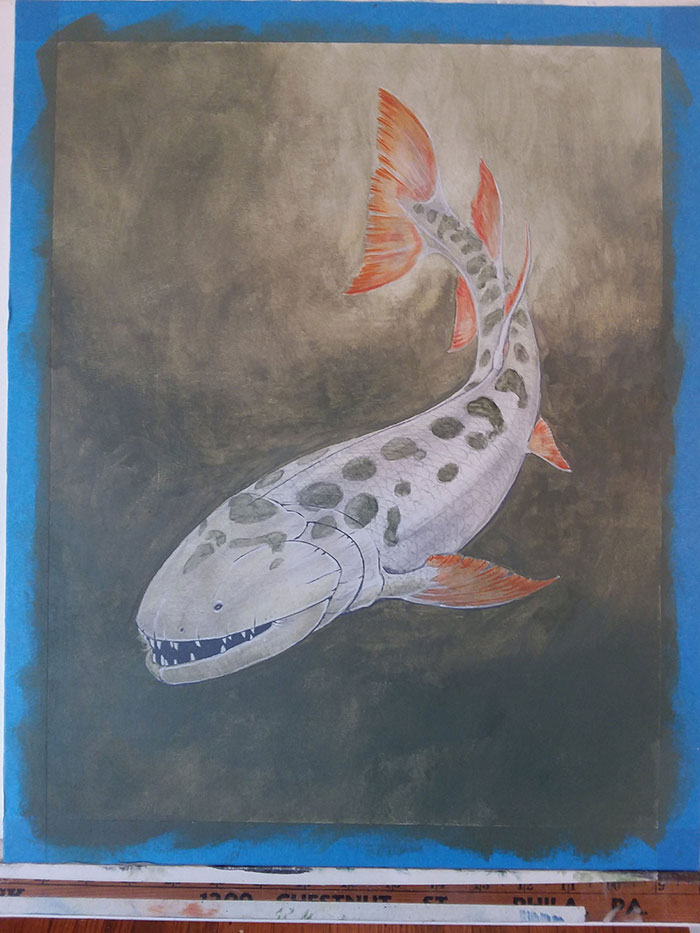
Poole chose to make Hyneria lindae’s fins reddish to show that they are reflecting red light from the sun, which is penetrating the surface of the water. He added green spots to the body, helping the fish blend in with the murky water while waiting to ambush prey. The white dots of paint in the water add sparkle as light bounces off the debris.

Is this exactly how Daeschler or Downs would have imagined Hyneria lindae? Probably not, but that’s the beauty of paleo art. After all, nobody has ever seen Hyneria lindae in the flesh. With a partnership between a stellar paleoillustrator and accomplished scientists, the result is the best possible interpretation. Unless we figure out how to travel back in time, the canvas version will just have to suffice.
This article originally appeared in the Academy of Arts and Sciences Blog